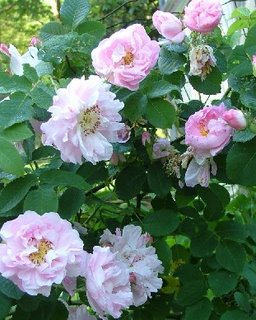Roses before all the rain.............



Roses! We have around 28 different roses: wild or species roses, old roses (some of which date to the Renaissance) and the rest are mostly Canadian super hardy roses. Although it hasn’t happened in the past few years, the temperature can get down to 25 below zero.
The photo with only one kind of rose is “The Milford Rose,” which dates back to the late 1700 and was brought here by the Pinchot family of Milford. It appears to have come from France and is very, very fragrant.
Behind the feverfew,the Apothecary rose is in the foreground, Nearly Wild behind that and a nameless very old rose in the back.
In the bottom photo, the white rose is Frau Karl Drushki; the pale pink is New Dawn and the red one is Blaze.
Luckily I got these photos before all the rain turned most of the blossoms to mush.








